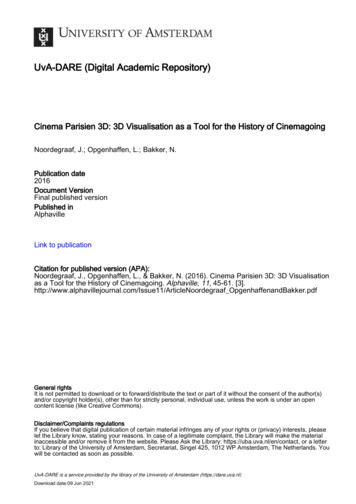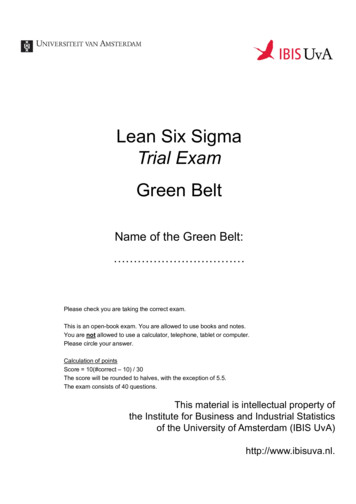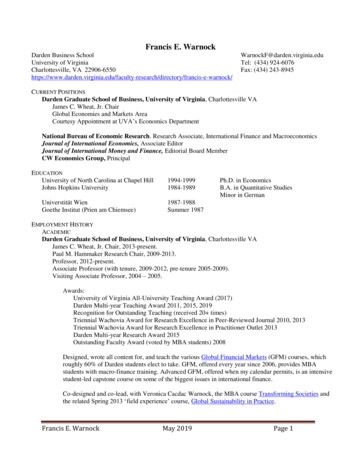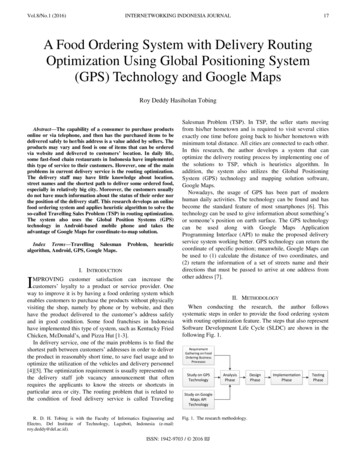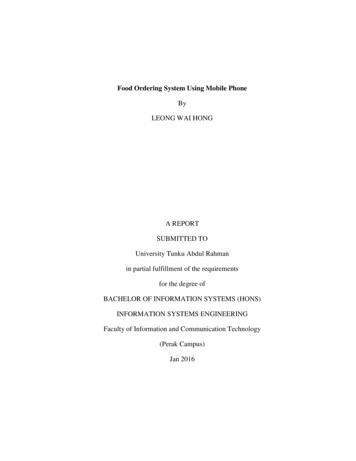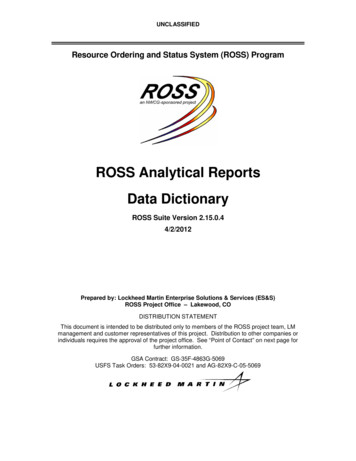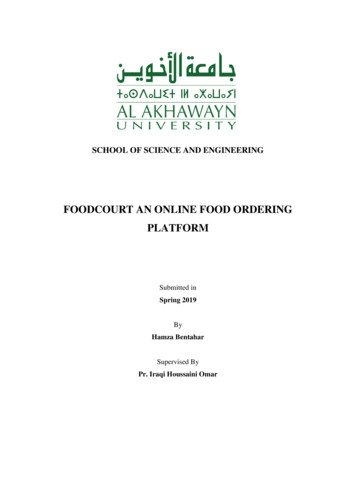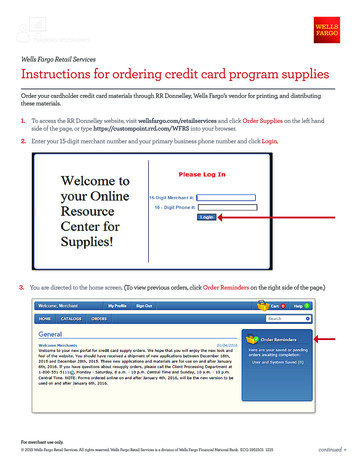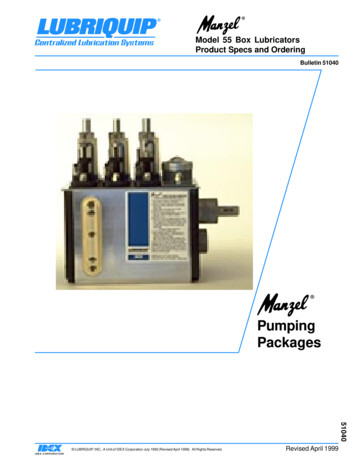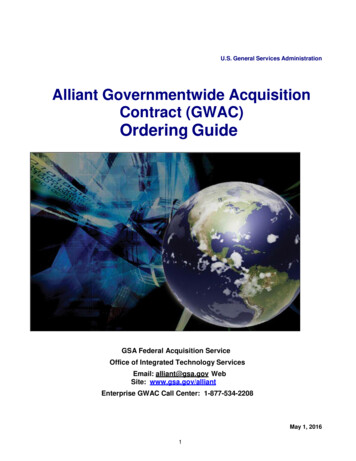
Transcription
Project Databases ReportPizzeria Ordering SystemTeachers :Assistant:Jos de BruinDr. Hamideh AfsarmaneshSimon MsanjilaStudents:Tyrone VriesdeTony CheongIvan va.nlIvanJoghi@gmail.com058806704774000564974
Executive SummaryA custom pizza online website was created for customers of a pizzeria to create theirorders online. The pizzeria has been taking orders by phone for a long time and theywanted to add the option for customers to create orders online.Existing webshop solutions involves putting products in categories. Such a division isnot suitable for ordering custom pizzas. There is a need to allow users to pickingredients for a pizza, ability to configure multiple custom pizzas and the ability toorder other products besides pizzas.Our solution separates the ordering of products in Non pizza products and CustomPizzas which consists of a selection of ingredients for pizzas.The website runs on Open Source software, it is written in PHP and uses MySQL asthe database manager.The website allows customers to create custom pizzas, pick non pizza products andenter delivery information. Employees can process accept or deny orders, and updatethe status as processing orders continues. The customer will be kept up to date by email notification when the order status changes. The administrator can add and editingredients, non pizza products and he can also add Employee accounts so theemployees can log in to process the orders.
Table of ContentsExecutive Summary .2Table of Contents.3Chapter 1: Problem description .41.1 Introduction.4Goal.4Existing solutions.4Our solution .4Technical constraints .41.2 Use Cases .5Ordering .5Order processing .5Administration .51.3 System specification .5Functionality specification.5Technical specification .61.4 Requirements .7Users .7Functional requirements.7Non-functional requirements .8Chapter 2: Approach .92.1 Technical Approach .10Chapter 3: Results .113.1 Architecture.11Information Architecture .11System Architecture.133.2 GUI Specification .133.3 Function implementation queries.16Chapter 4: Evaluation .25Chapter 5: Conclusion.33Appendix A:.34User manual .34
Chapter 1: Problem description1.1 IntroductionA pizzeria specialized in custom made pizzas is currently taking orders by phone.The current system where the customer calls the pizzeria takes time of employees toanswer the phone and is more work consuming than necessary. They want to allowcustomers to customize and order their pizzas online. The pizzeria also aims toincrease the sales, due to the easy to use order online website. The system will givethe employees more time to “work” rather then to accept orders by phone, also thepotential increase in customers are enough reason for the pizzeria to accept the change(website where customers can order their customized pizzas).GoalOur goal is to deliver a database with a user interface (website) where customers canselect various ingredients for their own pizza and place their order. The order will besent to the “kitchen” where the pizza will be made. The focus is to create an “easy touse” website, which will allow a first time customer to complete their order with ease.Existing solutionsThere are many different web based ordering systems. Those systems do not offer allthe functionality that is needed for a pizzeria. Ordering systems usually allow peopleto add products and separate them in different categories and subcategories.Pizzeria sells pizzas, and most of them also offer clients to customize their own pizzasby picking their own ingredients. At the same time they offer other products that donot need customization like the side orders. That does not fit into the generalcategory-subcategory differentiation.Our solutionOur solution is to make an ordering system that separates ordering pizzas fromordering the side dishes (non-pizza products) in an intuitive way.The ordering system provides the user with three tabs: one for customizing pizzas,one for side orders, and one for delivery details. Customers can switch to any tab anytime. Hence the system will decrease workload of the employees and benefit thepizzeria due to the database / information system. Information will be stored in thesystem and can be viewed at any time. The system will be able to guide a user throughthe website and make then complete their pizza order. When they are done with fillingin all information regarding their order they can complete the order to send it to thepizzeria.Technical constraintsThe constraints of this case are the network connectivity which is required and awebsite located on the internet. Customers will have to be able to customize theirpizzas. However there is a limit to the customization of the pizza, technicalconstraints, functions of the database and user interface. The system should make useof open-source software, since the pizzeria does not want an expensive system.
1.2 Use CasesThree main use cases are identified: ordering, order processing and administration.The following paragraphs describe each use case in more detail.OrderingThe first use case is ordering. To order, a potential customer must first know what hecan choose from (“What’s on the menu?”). For ordering custom pizzas a customerwill have to know the ingredients he can choose from and how choosing ingredientswill influence the total price. Customers pick ingredients for their pizza andsometimes they want a double portion of specific ingredients. When a customer isdone choosing his pizza, he may want to order several pizzas of the sameconfiguration. A customer may also want to order non-pizza side orders, such asdrinks and salads. Also the customer will have to provide his name, address andtelephone number. A customer can also pick another delivery date and time if theywish for the order to be delivered on a later date and time. Customers can order up totwo weeks in advance.Order processingWhen an order has been confirmed by a customer order processing begins.Throughout the order processing the order status will be updated and the customerwill be notified. New orders will show up in a list for the employees in the kitchen.They need to state which products are ordered and which ingredients are chosen forthe custom pizzas. The kitchen employees have to look at the order and decide if theycan prepare the order or not. When the decision is made, the order status will changeand the customer will be notified. After preparing the order the order status will beupdated and the delivery employees will take over. They will look up the name andaddress, and deliver the order. The customer will also be notified when the order isprepared and ready to be delivered. When delivery has been completed or failed, theorder status will be changed once more.AdministrationCustom pizzas are made by selecting several ingredients, the list of availableingredients and their prices are administrated by an employee, for instance themanager. Administration includes added, editing and deleting ingredients. Besides theadministration of ingredients, the non-pizza side orders must also be administrated.Administrators also need to have logs of previous orders.1.3 System specificationFunctionality specificationThe functionality specification is closely related to the use cases. The three mainfunctions are ordering, order processing and administration. A description of each ofthe functionality will follow. It includes the output of the system and the input itexpects from the users.Ordering involves customizing pizzas, selecting products and entering customerinformation. The system will have to provide the user with data about the ingredientsand the non-pizza products such as name and price. Users will provide an order which
consists of custom pizzas by selecting ingredients, non-pizza products, and customerinformation like name, address and telephone number. For every custom pizza andnon-pizza product users can also specify an amount if they wish to order more thanone of them.Order processing is involved in preparing and delivering orders. The system needs toprovide the kitchen employees with a list of pending orders. Of each order the orderedproducts and pizzas must be shown, together with the amount of each product. Foreach custom pizza the selected ingredients must also be shown. The kitchenemployees will first view the order and decide if they are going to process the order ornot. The decision will be entered by changing the status of the order to the respectivestatus. An e-mail will be sent to customer to keep him informed of the ordering status.After the order is prepared, the order will be passed to the delivery employees whowill use the system to retrieve the customer details. The status of the order willchange to “being delivered” and an new e-mail will be sent to the customer. When theorder is delivered, the delivery employee can mark the order as “delivered”, or in casehe failed to deliver it he will make it as “failed to deliver”.Administration includes adding, editing and deleting available ingredients, non-pizzaproducts and employees and viewing previous orders. The system will be able toshow a list of ingredients and a list of products. For each ingredient and non-pizzaproduct a name, price and picture can be specified. The system also needs a functionto show previous orders.Technical specificationThe system is made up of three layers. At the top there is the GUI (Graphical UserInterface) layer, the middle layer is the storage and query manager, the bottom layer isthe underlying database.GUI layerThe GUI layer allows users to access the system. All the functionalities of the systemmust be available through the GUI. There are two separate GUI’s. One is for thecustomers to create orders and one is for employees for processing orders andadministration purposes. With scripts, user input will be used to invoke queries fromthe storage and query manager layer to provide the user with various pages. The GUIshould prevent input errors and in case of errors that could not be prevented, provideclear error messages.Nowadays people have usernames and passwords for a lot of websites and services. Itis not practical to have users to remember information for a pizzeria. It is much easierfor customers to type in their name and address than to have to remember theusername and password. Therefore, customers do not have accounts to log on to.However customer information will be stored into the system to allow employeesview previous orders by customers.The GUI for employees is on a separate URL. Users need a username and a passwordto gain access to the system. The administrator has access to add users to the systemto give them access.Storage and query manager layerThe storage and query manager layer is responsible for information storage, retrieval,authorizations and error checking. This layer allows selecting, adding, updating,deleting entities and re
Our solution is to make an ordering system that separates ordering pizzas from ordering the side dishes (non-pizza products) in an intuitive way. The ordering system provides the user with three tabs: one for customizing pizzas, one for side orders, and one for delivery details. Customers can switch to any tab any time. Hence the system will decrease workload of the employees and benefit theFile Size: 1MBPage Count: 36
